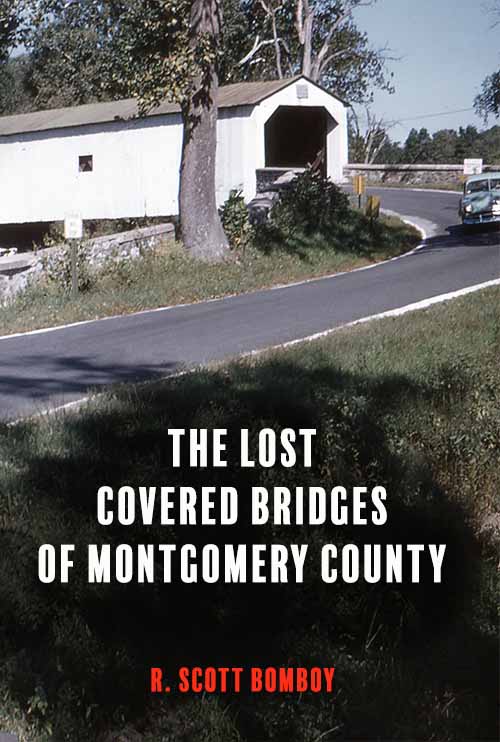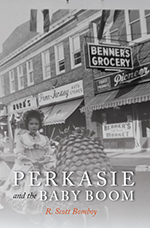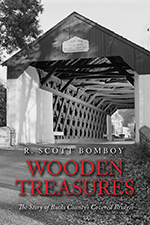Before 1958, there were few efforts to save Bucks County’s covered bridges. But after the South Perkasie covered bridge’s rescue in August 1958 by the town’s citizens, state and county officials adopted policies to preserve local covered bridges when feasible. Today, those policies have left 12 covered bridges in place in Bucks County.

Knecht’s Bridge in Springfield is a textbook example of a covered bridge still in road service. Image: Linn Lisher.
In August 1959, Bucks County celebrated Covered Bridge Day at the South Perkasie covered bridge reopening in Lenape Park. Prior to the event, Pennsylvania state highway director Park H. Martin said the state would change its policies to better promote covered bridge preservation. On July 25, 1959, Martin said wooden covered bridges on state roads would remain in place under certain conditions and the state would give communities every opportunity to preserve the bridges if they were on roads taken out of service.
All Posts In The Series
- Discovering Bucks County’s Covered Bridges (Part 1)
- The Delaware River Covered Bridge Network (Part 2)
- How Bucks County lost and then saved its covered bridges (Part 3)
- Modern Covered Bridge Preservation Efforts in Bucks County (Part 4)
In short, the state highway commission adopted the preservation tactics used to save the South Perkasie Covered Bridge as its own policy. The policy also granted legal possession of state-owned covered bridges to a “local historical society” or political subdivision if a state-owned bridge needed to be moved for preservation purposes. The policy also called for the Pennsylvania Historical and Museum Commission to play a role in the covered bridge preservation policy.[1]
In March 1960, Bucks County Township Officials Association officials and the Bucks County Boroughs Association pressed the state to repair two of its Bucks County covered bridges, as promised. Sam Thompson, the Township Officials Association president, told the Allentown Morning Call that the Sheard’s Mill Bridge, while in good shape, had been condemned by the state and Mood’s Bridge was in poor shape due to state neglect.[2] Soon after, repair work began on both bridges, with Mood’s Bridge getting a nearly complete overhaul in 1963.

Mood’s Bridge in 1957 before its restoration six years later. Image: Theodore Burr Covered Bridge Society.

Mood’s Bridge was leaning and missing much of its siding before this 1963 state-led restoration. Image: Theodore Burr Covered Bridge Society.
Bucks County officials adopted a similar policy for the eight bridges it owned in 1959. The county placed commemorative markers on all eight bridges, added directional road markers, and printed official covered-bridge road-tour maps. During the 1960s, Bucks County would aggressively promote its covered bridges as part of a broader tourism strategy. By early 1961, it had repaired and painted four of its bridges, with the others getting repairs by 1962.[3]
Bucks County also used some star power to promote its covered bridges. In 1961, author James A. Michener appeared in a national ad campaign, posing on the Frankenfield Covered Bridge, to promote the county as a business destination. Two years later, Prince Rainier and Princess Grace of Monaco visited the Bucks County Historical-Tourism Commission booth at a Philadelphia convention; the booth was designed as a replica covered bridge to attract visitors. The Bucks County also launched its Highways to History road marker program, featuring the county’s three historic symbols: William Penn, George Washington, and a Covered Bridge.

The 1963 Highways to History campaign stressed the county’s great symbols: Penn, Washington, and the Covered Bridge.
The state of Pennsylvania and the National Park Service placed Bucks County’s covered bridges on the National Register of Historic Places in 1980. “Bucks County today retains 13 of its original 35 or 37 covered bridges. The strict usage of the Town truss within the county is unusual and represents the largest number of Town truss bridges anywhere in the State,” said Ed Weintraub from the PHMC’s State Office of Historic Preservation. “In an area that saw the birth and development of the covered bridge, these rare survivors are the only remaining examples of an important stage in the development of bridge technology and history.”[4]
The National Register made a special exception for the South Perkasie Covered Bridge since structures moved from their original location aren’t usually considered eligible for the National Register. “Only the efforts of the local historical society saved the bridge at all. Today, the bridge sits near its original location, and while on land, possesses integrity of construction and location.”[5]
Bucks County officials have continued to make covered bridge maintenance a priority. Weintraub had noted in his 1980 National Register nomination that all county-owned covered bridges were in good to excellent condition, while two of the state-owned bridges were poorly maintained.
But in January 1985, arsonists destroyed the county bridge at Haupt’s Mill in Springfield Township. While the county received more than 1,000 petitions for it to fund a replica bridge, commissioners decided in February 1987 to not build any bridge at the location, citing lack of support from township supervisors and residents at the location; a lack of traffic on the old bridge; and unbudgeted costs of $400,000.[6]
Since then, two state-owned covered bridges lost to arsonists have been replaced with replica covered bridges. In 1991, a fire destroyed the Twining Ford Covered Bridge in Tyler State Park. Local residents and politicians raised the funds for a replica bridge and took part in its construction; the new bridge debuted as a walking-only bridge in 1997.

Twining Ford Bridge comes back to life after a fire destroyed the original bridge.
And in 2004, Mood’s Bridge in Perkasie, which was closed for repairs, also fell victim to arsonists. Local residents worked with government officials to fund and construct a $700,000 replacement bridge, which was placed back it road service in 2008.
Today, covered bridge historic preservation is supported at a state-level in the PHMC’s Statewide Historic Preservation Plan and through grants offered by the commission. Bucks County’s tourism agencies still heavily promote the bridges. But an important source of covered bridge funding was lost in 2012 when the federal government ended its National Historic Covered Bridge Preservation Program. The job of covered bridge preservation currently resides with local governments that maintain bridges remaining in public service and local community groups that raise funds to support those efforts.
In 2015, the National Park Service published an exhaustive 234-page history of covered bridge engineering and preservation. It concluded with the following thought. “What is the future of these historic resources, which have such a hold on the American imagination?” the authors asked. They pointed to the cooperation of citizens with government agencies to ensure covered bridges “long remain standing in the American landscape.”[7]
In Bucks County, communities have pioneered such efforts for the past 60 years, recognizing the covered bridge network’s long role in the villages, townships, and boroughs that make Bucks County unique. Perhaps its citizens were inspired by Anderson Scruggs’ famous poem from 1932 called “The Covered Bridge.”[8]
“Here was a refuge from the sudden showers That swept like moving music field and wood. And here cool, tunneled dark when sultry hours. Danced with white feet beyond the bridge’s hood. … Yet there are soulless men whose hand and brain tear down what time will never give again.”
Footnotes
[1] “Covered Bridge Policy Announced,” The Standard-Sentinel (Hazelton, Pa.), July 25, 1959, 12.
[2] “Bucks Officials Press for Repair of 2 Spans,” The Morning Call (Allentown, Pa.), March 9, 1960, 12.
[3]“Bob Reinhardt, “Going in Circles,” The Daily Courier (Bristol, Pa.), January 9, 1961, 3.
[4] National Register Nomination Form, Covered Bridges of the Delaware River Watershed, 8.
[5] National Register Nomination Form, Covered Bridges of the Delaware River Watershed, 6.
[6] “Bucks Won’t Replace Covered Bridge,” The Morning Call (Allentown, Pa.), February 19, 1987, 17.
[7] Justine Christianson and Christopher H. Marston, eds. Covered Bridges and the Birth of American Engineering. (Washington, D.C.: National Park Service, Historic American Engineering Record, 2015), 199.
[8] Anderson Scruggs, “The Covered Bridge,” Selinsgrove Times-Tribute (Selinsgrove, Pa.), September 15, 1932, 4.






